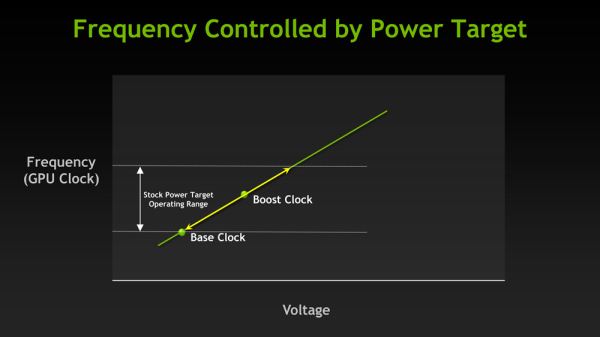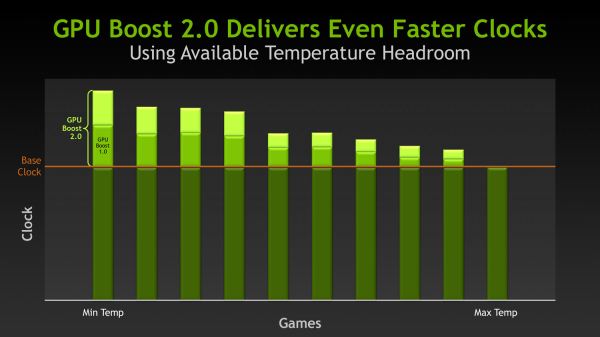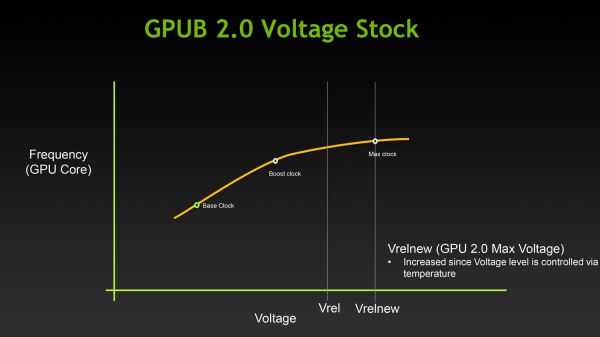NVIDIA's GeForce GTX Titan, Part 1: Titan For Gaming, Titan For Compute
by Ryan Smith on February 19, 2013 9:01 AM ESTGPU Boost 2.0: Temperature Based Boosting
With the Kepler family NVIDIA introduced their GPU Boost functionality. Present on the desktop GTX 660 and above, boost allows NVIDIA’s GPUs to turbo up to frequencies above their base clock so long as there is sufficient power headroom to operate at those higher clockspeeds and the voltages they require. Boost, like turbo and other implementations, is essentially a form of performance min-maxing, allowing GPUs to offer higher clockspeeds for lighter workloads while still staying within their absolute TDP limits.
With the first iteration of GPU Boost, GPU Boost was based almost entirely around power considerations. With the exception of an automatic 1 bin (13MHz) step down in high temperatures to compensate for increased power consumption, whether GPU Boost could boost and by how much depended on how much power headroom was available. So long as there was headroom, GPU Boost could boost up to its maximum boost bin and voltage.
For Titan, GPU Boost has undergone a small but important change that has significant ramifications to how GPU Boost works, and how much it boosts by. And that change is that with GPU Boost 2, NVIDIA has essentially moved on from a power-based boost system to a temperature-based boost system. Or perhaps more precisely, a system that is predominantly temperature based but is also capable of taking power into account.
When it came to GPU Boost 1, its greatest weakness as explained by NVIDIA is that it essentially made conservative assumptions about temperatures and the interplay between high temperatures and high voltages in order keep from seriously impacting silicon longevity. The end result being that NVIDIA was picking boost bin voltages based on the worst case temperatures, which meant those conservative assumptions about temperatures translated into conservative voltages.
So how does a temperature based system fix this? By better mapping the relationship between voltage, temperature, and reliability, NVIDIA can allow for higher voltages – and hence higher clockspeeds – by being able to finely control which boost bin is hit based on temperature. As temperatures start ramping up, NVIDIA can ramp down the boost bins until an equilibrium is reached.
Of course total power consumption is still a technical concern here, though much less so. Technically NVIDIA is watching both the temperature and the power consumption and clamping down when either is hit. But since GPU Boost 2 does away with the concept of separate power targets – sticking solely with the TDP instead – in the design of Titan there’s quite a bit more room for boosting thanks to the fact that it can keep on boosting right up until the point it hits the 250W TDP limit. Our Titan sample can boost its clockspeed by up to 19% (837MHz to 992MHz), whereas our GTX 680 sample could only boost by 10% (1006MHz to 1110MHz).
Ultimately however whether GPU Boost 2 is power sensitive is actually a control panel setting, meaning that power sensitivity can be disabled. By default GPU Boost will monitor both temperature and power, but 3rd party overclocking utilities such as EVGA Precision X can prioritize temperature over power, at which point GPU Boost 2 can actually ignore TDP to a certain extent to focus on power. So if nothing else there’s quite a bit more flexibility with GPU Boost 2 than there was with GPU Boost 1.
Unfortunately because GPU Boost 2 is only implemented in Titan it’s hard to evaluate just how much “better” this is in any quantities sense. We will be able to present specific Titan numbers on Thursday, but other than saying that our Titan maxed out at 992MHz at its highest boost bin of 1.162v, we can’t directly compare it to how the GTX 680 handled things.













157 Comments
View All Comments
bigboxes - Tuesday, February 19, 2013 - link
This is Wreckage we're talking about. He's trolling. Nothing to see here. Move along.chizow - Tuesday, February 19, 2013 - link
I agree with his title, that AMD is at fault at the start of all of this, but not necessarily with the rest of his reasonings. Judging from your last paragraph, you probably agree to some degree as well.This all started with AMD's pricing of the 7970, plain and simple. $550 for a card that didn't come anywhere close to justifying the price against the last-gen GTX 580, a good card but completely underwhelming in that flagship slot.
The 7970 pricing allowed Nvidia to:
1) price their mid-range ASIC, GK104, at flagship SKU position
2) undercut AMD to boot, making them look like saints at the time and
3) delay the launch of their true flagship SKU, GK100/110 nearly a full year
4) Jack up the prices of the GK110 as an ultra-premium part.
I saw #4 occurring well over a year ago, which was my biggest concern over the whole 7970 pricing and GK104 product placement fiasco, but I had no idea Nvidia would be so usurous as to charge $1k for it. I was expecting $750-800....$1k....Nvidia can go whistle.
But yes, long story short, Nvidia's greed got us here, but AMD definitely started it all with the 7970 pricing. None of this happens if AMD prices the 7970 in-line with their previous high-end in the $380-$420 range.
TheJian - Wednesday, February 20, 2013 - link
You realize you're dogging amd for pricing when they lost 1.18B for the year correct? Seriously you guys, how are you all not understanding they don't charge ENOUGH for anything they sell? They had to lay of 30% of the workforce, because they don't make any money on your ridiculous pricing. Your idea of pricing is KILLING AMD. It wasn't enough they laid of 30%, lost their fabs, etc...You want AMD to keep losing money by pricing this crap below what they need to survive? This is the same reason they lost the cpu war. They charged less for their chips for the whole 3yrs they were beating Intel's P4/presHOT etc to death in benchmarks...NV isn't charging too much, AMD is charging too LITTLE.AMD has lost 3-4B over the last 10yrs. This means ONE thing. They are not charging you enough to stay in business.
This is not complicated. I'm not asking you guys to do calculus here or something. If I run up X bills to make product Y, and after selling Y can't pay X I need to charge more than I am now or go bankrupt.
Nvidia is greedy because they aren't going to go out of business? Without Intel's money they are making 1/2 what they did 5yrs ago. I think they should charge more, but this is NOT gouging or they'd be making some GOUGING like profits correct? I guess none of you will be happy until they are both out of business...LOL
chizow - Wednesday, February 20, 2013 - link
1st of all, AMD as a whole lost money, AMD's GPU division (formerly ATI) has consistently operated at a small level of profit. So comparing GPU pricing/profits impact on their overall business is obviously going to be lost in the sea of red ink on AMD's P&L statement.Secondly, the massive losses and devaluation of AMD has nothing to do with their GPU pricing, as stated, the GPU division has consistently turned a small profit. The problem is the fact AMD paid $6B for ATI 7 years ago. They paid way too much, most sane observers realized that 7 years ago and over the past 5-6 years it's become more obvious. The former ATI's revenue and profits did not justify the $6B price tag and as a result, AMD was *FORCED* to write down their assets as there were some obvious valuation issues related to the ATI acquisition.
Thirdly, AMD has said this very month that sales of their 7970/GHz GPUs in January 2013 alone exceeded sales of those cards in the previous *TWELVE MONTHS* prior. What does that tell you? It means their previous price points that steadily dropped from $550>500>$450 were more than the market was willing to bear given the product's price:performance relative to previous products and the competition. Only after they settled in on that $380/$420 range for the 7970/GHz edition along with a very nice game bundle did they start moving cards in large volume.
Now you do the math, if you sell 12x as many cards in 1 month at $100 profit instead of 1/12x as many cards at $250 profit over the course of 1 year, would you have made more money if you just sold the higher volume at a lower price point from the beginning? The answer is yes. This is a real business case that any Bschool grad will be familiar with when performing a cost-value-profit analysis.
CeriseCogburn - Sunday, February 24, 2013 - link
Wow, first of all, basic common sense is all it takes, not some stupid idiot class for losers who haven't a clue and can't do 6th grade math.Unfortunately, in your raging fanboy fever pitch, you got the facts WRONG.
AMD said it sold more in January than any other SINGLE MONTH of 2012 including "Holiday Season" months.
Nice try there spanky, the brain farts just keep a coming.
frankgom23 - Tuesday, February 19, 2013 - link
Who wants to pay more for lessno new features..., this is a paper launch of a useless board for the consumer, I don't even need to see official benchmarks, I'm completely dissapointed.
Maybe it's time to go back to ATI/AMD.
imaheadcase - Tuesday, February 19, 2013 - link
If you would actually READ the article you would know why.I love how people cry a river without actually knowing how the card will perform yet.
CeriseCogburn - Sunday, February 24, 2013 - link
Yes, go back, your true home is with losers and fools and crashers and bankrupt idiots who cannot pay for their own stuff.The last guy I talked to who installed a new AMD card for his awesome Eyefinity monitors gaming setup struggled for several days encompassing dozens of hours to get the damned thing stable, exclaimed several times he had finally achieved, and yet, the next day at it again, and finally took the thing, walked outside and threw it up against the brick wall "shattering it into 150 pieces" and "he's not going dumpster diving" he tells me, to try to retrieve a piece or part of it which might help him repair one of the two other DEAD upper range amd cards ( of 4 dead amd cards in the house ) he recently bought for mega gaming system.
ROFL
Yeah man, not kidding. He doesn't like nVidia by the way. He still is an amd fanboy.
He is a huge gamer with multiple systems all running all day and night - and his "main" is "down"... needless to say it was quite stressful for him and has done nothing good for the very long friendship.
LOL - Took it and in a seeing red rage and smashed that puppy to smithereens against the brick wall.
So please, head back home, lots of lonely amd gamers need support.
iMacmatician - Tuesday, February 19, 2013 - link
"For our sample card this manifests itself as GPU Boost being disabled, forcing our card to run at 837MHz (or lower) at all times. This is why NVIDIA’s official compute performance figures are 4.5 TFLOPS for FP32, but only 1.3 TFLOPS for FP64. The former assumes that boost is enabled, while the latter is calculated around GPU Boost being disabled. The actual execution rate is still 1/3."But the 837 MHz base and 876 MHz boost clocks give 2·(876 MHz)·(2688 CCs) = 4.71 SP TFLOPS and 2·(837 MHz)·(2688 CCs)·(1/3) = 1.50 DP TFLOPS. What's the reason for the discrepancies?
Ryan Smith - Tuesday, February 19, 2013 - link
Apparently in FP64 mode Titan can drop down to as low as 725MHz in TDP-constrained situations. Hence 1.3TFLOPS, since that's all NVIDIA can guarantee.